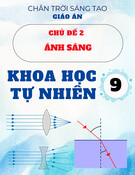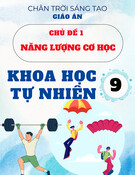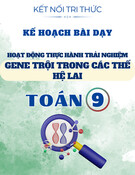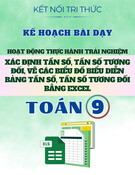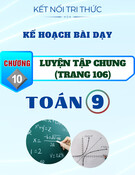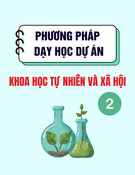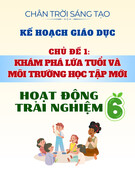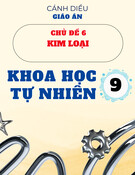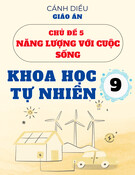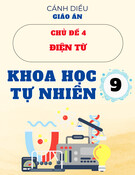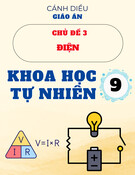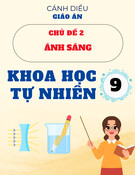PERIOD 65 / WEEK 22
Unit 8 : TOURISM Lesson 1 GETTING STARTED: Travel plans
I. OBJECTIVES: By the end of this Unit, students will be able to: (cid:0) use the lexical items related to tourism
II . PREPARATION: sub board, pictures, cassette III. PROCEDURES:
Teacher’s and students’ activities Content
1)Listen and read / p.18
Activity 1: Let Ss open their book to GETTING STARTED Tell them to look at the picture and answer the questions: What are Nick and Chau talking about? What place/ city may they be mentioning? What do you know about thus city country? Tell Ss they are going to listen to Nick and Chau talking about Nick’s plans for his summer holiday. Play the recording and have sts follow along. a) Play the recording twice or more Sts do the exercise individually. Check and write the correct answers on the board. T may call on an able st to write the answers on the board.
Ex a) Find a word / phrase in the conversation that means: 1. made up your mind 2.narrowed it down 3. a package tour 4.explore 5.not my cup of tea
Explain to sts the meaning and the use of the three expressions in the Watch out box. Ask Ss to locate them in the conversation. ) true (T) or false b) Sts work in pairs.
Tell them to refer back to the conversation when necessary. Explain anything difficult. T needs to explain to Ss “snails and frogs’ legs are specialities in France.
c) Sts work individually, then compare their answers with a
partner. Help them find the information in the conversation. Call on some pairs ro read out the questions and give their answers. Check their answers.
Ex b)Tick ( (F) 1. F 2.T 3.T 4.F 5.F Ex c) Answer the following questions. 1.It means Nick’s parents are relaxed and openminded. 2. It’s quite warm ( warmer than in Britain) 3.Visit the Alps , and climb Mont Blanc, explore Paris , and go sightseeing in the historic city of Versailles.
Activity 2: This activity aims at giving the collocations of common words related to the topic of travelling and tourism. Sts work in pairs first. Check their work, then let them read and remember each collocation.
Activity 3: This exercise is a revision of words / phrases from previous lessons. Let Ss work individually to do the task. Check their answers. If time allows , call on some Ss to read the passage with the correct answers.
4. Eat frogs’legs and snails. 5.She says “ lucky you” when Nick says he can make his own decisions. Ex2) Collocation: Which word goes with which list below? 1.hoilday 2.resort 3.tour 4.trip Ex3) Fill each blank with a word / phrase from the list. 1. seaside resort 2.souvenir 3.destination 4.in advance 5. delayed 6.luggage 7.accommodation 8.price
Activity 4: Sts do the exercise individually, then check their answers. T may encourage each St to make a similar quiz for their partner to do. T may pick up any interesting questions and give them to the whole class. Praise good ideas. Sts work in groups for 4, 5, 6. Check and give comments. Ex4) Quiz. 1. Da Nang City 2. The Great Wall of China 3. Jeju island 4. Ss’ answers 5. Ss’ answers 6. Ss’ answers
V HOMEWORK: Practice reading the dialogue. Write new words then learn them by heart. Copy the exercise into notebooks. Prepare for A CLOSER LOOK 1
PERIOD 66 / WEEK 22
Unit 8 : TOURISM Lesson 2 – A CLOSER LOOK 1
I. OBJECTIVES: By the end of this Unit, students will be able to (cid:0) use common compound nouns.
II . PREPARATION: sub board, pictures, cassette III. PROCEDURES:
Teacher’s and students’ activities Content
Activity 1: Ss work individually, then compare their answers with a partner’s. Ask some Ss to write their answers on the board. Check theirs answers as a class. Have them make sentences with the words if necessary.
VOCABULARY Adjectives 1.tour 2.resort 3.travel 4.tour guide 5.trip 6.expedition
Activity 2: Sts work in pairs. Call on some Ss to write the answers on the board. Correct as a class. T may ask some Ss to answer some questions about the passage: What piece of writing is it? ( introduction of a tourist attraction? itinerary? advertisement?) What is EcoTours? ( A travel Agency / company?) What is special about EcoTours? ( It gives some money to protect the environment)
Give examples of the compound nouns Ss already know: blackboard, swimming pool, haircut, tablespoon.. Ask them to give some more. Help sts study the Grammar box and the Look out box. Tell them to look up the spelling of words in the dictionary if they are not sure.
1.travel 2.book 3.visit 4.environment 5.guides 6.holiday 7.reasonable 8.pleased Compound nouns A compound noun is a noun that is made of two or more words. Compound nouns can be formed using the following combinations. Noun + noun : toothpaste Noun + verb : rainfall Noun + particle : passerby Verb + Particle : check out Verbing + noun : driving license Adjective + noun : greenhouse Look out A compound noun can be written as a single word
( motorbike), a word with a hyphen ( passerby) , or two words ( driving license)
Particle + noun : underground Particle + verb : output Note : A particle is a preposition or an adverb
1. jet lag 2.drawback 3.stopover 4.peak season 5.checkin 6.bus stop Activity 3: Ss work individually. Tell them to look at the words given and think which of them can go with which one in each definition. When they finish, check their answers and write the words on the board. Ask sts to take notice of the spelling : whether the words are written as one word or as two separate words, or with a hyphen.
Activity 4 Sts work in pairs. Have them read the sentences carefully and insert the compound nouns appropriately. Check their answers as a class. Explain anything difficult.
First write a finding out question and a making sure question on the board. Read the two questions to Ss with the right tone ( several times if necessary) and let them give the rules. Explain the Look Out Box to them.
Activity 5 Play the recording once for Ss to listen, then play it again sentence by sentence for them to repeat. Have Ss repeat the questions as many times as necessary. Correct their pronunciation and intonation. After that have Ss mark the questions with a falling or fallingrising tone. Check as a class. 1.checkout 2.swimming pool 3.mixup 4. pile up 5.touchdown 6.full board PRONUNCIATION Tones in asking for information. Finding out questions ( ‘ open’ questions) usually end with a falling tone: What part of Australia have you been to? Making sure questions ( ‘ check’ questions) usually end with a falling raising tone: Have you just come back from South Africa? 1.Where would you like to go sightseeing? 2. What do you think of the newly discovered cave? 3. Have you been sightseeing all day? 4. Is Egypt a famous tourist attraction?
Activity 6 Sts work in pairs to read the conversation, and mark the questions with falling or fallingrising arrows. Call on some pairs to read aloud to the class. Do not correct their mistakes yet. Play the recording. Ss listen and check.
What’s the matter, Janet? I’m looking for my passport. It seems to be lost. Have you already searched your purse? Not yet. Oh, where are my glasses? They may be in your plastic bag. Where is it? Oh, no. It’s not here. Have I dropped it on the plane?
Oh my God. What should I do now? Let’s report it to the customs office.
IV HOMEWORK: Write new words then learn them by heart. Copy the exercise into notebooks. Prepare for A CLOSER LOOK 2
PERIOD 67 / WEEK 23
UNIT 8 : TOURISM LESSON 3 A CLOSER LOOK 2
I. OBJECTIVES: By the end of this Unit, students will be able to (cid:0)
(cid:0) use a / an / the / and zero article. use some common phrasal verbs correctly and appropriately.
II . PREPARATION: sub board, pictures, cassette III. PROCEDURES:
Teacher’s and students’ activities Content
Explain carefully the uses of a, an, the , and zero article in the REMEMBER box. Give more examples Introduce the special use of the Look Out box. Refer back to the conversation in HETTING STARTED and ask sts to find the special use of the .
GRAMMAR Articles : other uses ( a / an – the zero article) Look out We use the with the name of a few countries : The UK, The USA, The Netherlands, The Philippines. We also use the with islands groups, mountain ranges, oceans and names of rivers.: The Thames, The Pacific, The Amazon, The Danube. Ex1) Complete the text with a / an / the Ø ) . / or zero article ( 1.a 2.the 3. the 4. the 5. the 6. ( no article) 7. the Activity 1: T may have to give Ss some information about the Dominican Republic. Location: on the island of Hispaniols, in the Caribbean region. Area: 48, 445 square kilometers. Official language :Spanish. Have some Ss work individually to compare the task. Tell them to refer the Grammar box.
Have them compare their answers with a partner’s . Give the correct answers and explain the use of a certain article in some cases.
Activity 2:
a) Sts work in groups and study the proper names in the list, and try to agree on which of these names have the before them. Then Ss ask and answer the questions. Check and give explanation if necessary.
8. ( no article) 9. ( no article) 10. the 11. ( no article) 12. ( no article) 13. the 14.an Ex2a) Ask and answer the questions. Choose from the list. Use ‘the’ if necessary. 1.the Forbidden City 2.the Thames 3. Lake Baikal 4. Ha Long Bay 5. Son Duong Cave 6. The Statue of Liberty Ex2b) Choose one item above and say what you know about it as a tourist attraction.
b) Sts work in groups. Tell Ss that each of them chooses one item in 2a) and says what they know about it as a tourist attraction. Give them two or three minutes to prepare before they talk.
Activity 3:
a) Sts work individually. Make sure they understand
fully that they have to write down in their notebooks. the answers to questions 15 , using a, an, the , or zero article in each answer. Remind them that they answer three questions truthfully, but write untrue answers for the other two. Go around and assist where and when necessary.
Ex 3a) Write answer to the questions, using a, an, the or zero article in each answer. Give three true answers, but two untrue ones.. 1. 2. 3. 4. 5. Ex 3b)Tell your answer to a partner and ask him / her to guess which answers are not true.
b) After Ss finish 3a), let them form pairs and swap their answers Each of them has to read carefully and guess which ones of their partner’s answers are true, and which are not. This activities should be fun , so do not try to correct the mistakes in their writing.
Activity 4: Sts work individually to make sentences from words / phrases, and write them down. Tell Ss to pay attention to the use of articles in their sentences. Then they work in pairs to check each other’s work, and discuss which of the sentences are true, and which are false.
Ex 4)Make full sentences from the words or phrase , adding articles as needed. Then mark them as true (T) or false (F). 1. F 2. T 3. F 4. T 5. T
IV HOMEWORK: Write new words then learn them by heart. Copy the exercise into notebooks. Prepare for COMMUNICATION
PERIOD 68 / WEEK 23
Unit 8 : TOURISM Lesson 4 COMMUNICATION
I. OBJECTIVES: By the end of this Unit, students will be able to (cid:0)
(cid:0) ask questions for information with the correct intonation. talk about important features of a city.
II . PREPARATION: sub board, pictures, cassette III. PROCEDURES:
Teacher’s and students’ activities Content
Extra vocabulary breathtaking not breaking the bank affordable
Ex 1a) Read the following information about tourism in Viet Nam. Students’ answers Ex1b) Work in groups. Discuss the visitors’ opinions. Do you agree? Add two more reasons to the list.. Activity 1: a)Have Sts quickly read the information about tourism in Viet Nam. Tell them to look at the picture sand read that these foreign visitors say about their choice of Viet Nam as a holiday destination.
b) Ss work in groups of five or six. Have them discuss the visitors’ opinions in 1a) . Sts may or may not agree with these opinions. Ask for the class’s agreement by a show of hands for each tourist’s opinion. if any Ss do not agree, ask them to explain why. Then let each of Ss add two more reasons to the list. T may give some cues : cultural diversity beautiful beaches easy and various means of transport traditional festivals natural beauty Activity 2: Have Ss read the facts about the topten most visited countries. Sts work in pairs and complete the table by writing one or two famous things that visitors can see or do in each country. Have them write on a large sheet of paper. As Ss have already prepared for this, it will not take much time, so give them a few minutes only. After each pair finishes, they swap pairs. Continue until they have filled all the ten countries.
Ex 2) These are the topten most visited countries according to the figures published by the United Nations World Tourism Organisation ( UNWO) . Work in pairs. Complete the table by writing one or two famous things that visitors can see or do in each country. 1.France: Go up the Eiffel Tower , visit the Louvre Museum in Paris. 2.United States: visit the Statue of Liberty, visit the Grand Canyon, shop in New York, go surfing in Hawaii. 3.Spain: Pour Madrid, visit the legendary land of Don Quixote, visit the Olympic Ring in Barcelona 4.China: Climb the Great Wall, tour Beijing National Stadium ( Bird’s Nest) , Tour The Forbidden City, visit the Stone Forest. 5.Italy: visit the Vatican City, visit famous Museum, Tour Florence , Tour Venice. 6. Turkey: enjoy Turkish cuisine in Istanbul, go sightseeing in the Bosphonus ( the strait separating two continents Europe and Asia) , visit Buyuk Ada ( Big island in Prince’s islands) 7.Germany : visit the “ Jewel of the Middle Ages” –Rothenburg ob der Tauber( = Rothenburg above the Tauber ) , visit the famous “ Cinderella castle” , go up the BerlinTower , take the Berlin Segway Tour. 8.United Kingdom: go sightseeing in London, visit Stonehenge, visit Liverpool, home of the Beatles 9.Russia : Tour Moscow, ( The Kremlin, Red Square, Moscow metro..) visit St. Peterburg, Hermitage Museum, Cruise on Neva river,
experience the White Nights. 10Mexico: Visit the UNESCO world heritage site of Antigua,have a boat tour on the water of Rio Duice, try the delicious local speciality tapado(= seafoodcoconut soup) climb some of the tallest Mayan temples. Ex3) Work in groups. Discuss which country/ place you would like to visit for a holiday. Ex : I’d like to go to Spain for my holiday. It would be wonderful to tour Madrid, and visit the legendary land of Don Quixote. ……………………………………….. ……………………………………….. ………………………………………... ……………
Activity 3: Sts work in groups of five or six to talk about their choice of holiday. Tell them to give the reasons why , and say what they can do there. Encourage them to talk as mush as possible . Walk around to observe and give help if needed.
IV HOMEWORK: Write new words then learn them by heart. Copy the exercise into notebooks. Prepare for SKILLS 1
PERIOD 69 / WEEK 23
Unit 8 : TOURISM Lesson 5 SKILLS 1
(cid:0)
(cid:0) I. OBJECTIVES: By the end of this Unit, students will be able to read for general and specific information about a tourist attraction. talk about their choice of holiday
II . PREPARATION: sub board, pictures, cassette III. PROCEDURES:
Teacher’s and students’ activities Content
Activity 1:
a) Ss work in groups and name some famous READING Ex1a) Work in groups . Name some
caves in Viet Nam and in the world that they have prepared already for homework.
b) Ss work in pairs and answer the questions
famous caves in Viet Nam and in the word In Viet Nam: Phong Nha Cave En Cave Thien Duong Cave Sung Sot Cave ( Ha Long Bay) Tam Coc –Bich Dong Cave ( Ninh Binh) In the world: Deer Cave ) Borneo , Malaysia) Onondaga Cave( Missouri, USA) Gouffre Berger( France) Reed Flute Cave( Gullin, China) Fingal’s Cave( Scotland) Cave of Crystals ( Mexico) Ex1b) Answer the questions with your own ideas. 1. 2. 3. with their own ideas. Sts are not allowed to read the passage. T doesn’t need to check their answers and correct mistakes.
Now read the passage and check the information.
Have Ss quickly read the passage and check the information themselves. Sts write down the correct answers in their notebooks.
Activity 2: T may have Ss read the passage in chorus first, paying special attention to new words. Explain and clarify anything difficult. Then allow Ss time to read the passage individually, silently or aloud. Call on sts to read aloud to the class. Check their pronunciation and intonation. Have them ask and answer the questions in pairs. Tell them to note where they can find the information for answering the questions or choosing the correct answers. Correct the answers as a class. Ex2) Read the passage again and answer the questions, or choose the correct answers. 1.The American Broadcasting Company ( ABC) aired a live program ( featuring the magnificence of Son Duong) on ”Good morning America” 2.By river water eroding away the lime stone underneath the mountain 3.From February to August 4. C 5.D
SPEAKING Ex3) Which would you like to do most on ) three things in the list. holiday ? Tick ( 1. Ss’ answers 2. 3. Activity 3: Have sts study the list of holiday ideas. Ask sts what they think about these ways of spending one’s holiday and whether they have done any of them. Then let them choose three things from the list.
Activity 4: Ex4) Work in groups. Talk about one of your choices, trying to persuade your
group to join you.
Sts work in groups of five or six. Tell them to refer to the three things they have ticked in 3 . Let them choose one and prepare to talk about it . Tell them to study the example carefully as a model. Give them some time before each group member shares his / her choice of holiday.
IV HOMEWORK: Write new words then learn them by heart. Copy the exercise into notebooks. Prepare for SKILLS 2
PERIOD 70 / WEEK 24
Unit 8 : TOURISM Lesson 6 – SKILLS 2
I. OBJECTIVES: By the end of this Unit, students will be able to
(cid:0) listen for specific information about the benefits of tourism to an area / country
(cid:0) write a paragraph about the negative effects of tourism on an area / country. II . PREPARATION: sub board, pictures, cassette III. PROCEDURES:
Teacher’s and students’ activities Content
) true (T) or
Activity 1: Let Ss work in pairs. Encourage Ss to think about the importance of tourism to Viet Nam. Elicit as many ideas from them as possible. Activity 2: Play the recording one or two times. Clarify anything unclear or difficult. Ask Ss to listen carefully and tick T / F as they hear answers in the lecture. T plays the recording again for less able Ss.
x3) Listen again and choose the
LISTENING ex1) Work in pairs. is tourism important to Viet Nam? give at least one reason. Ex2) Listen and tick ( false (F) . 1.T 2.T 3. F 4. T 5.T 6.F Ẻ correct answer. Key : C
Activity 3: Play the recording again. Tell Ss to pay special attention to the last sentence of the lecture. Then they choose the correct answers as required. Correct as a class.
WRITING Ex4) Work in groups. Talk about the negative effects of tourism on a region or country. The following ideas may be helpful to you.. Activity 4: Have Ss work in groups and discuss the negative effects of tourism on their locality .Tell Ss to study the prompts given , and give some more if possible.
Activity 5: Have Ss read any of their previous work about the negative effects of something. Let them choose one negative effect that they have discussed in 4) and write a paragraph in about 100 120 words. When they have finished, tell them to swap their writing and check each other’s work.
Ex5) Choose one negative effect that you have discussed above and write a paragraph about it. Make sure you use the right connectors. : first /firstly / the first / one of the …… second/ secondly /another …. third/ thirdly / furthermore / in addition …. Sample writing: One of the drawbacks of tourism is the damage to the environment of a country or area. In the first place, tourists use a lot of local resources such as water , food, energy , etc … and this put pressure on the environment. Secondly, there is the
problem of pollution. Many cities and towns become overcrowded with tourists, with all their vehicles causing traffic jams as well as air and noise pollution. Another bad effect of tourism is the destruction of the wide life in some places. The habitat of wild plants and animals is lost because of the building of tourist resorts, and by visitors’ activities. In short, the development of tourism has bad effects on the environment.
IV HOMEWORK: Write new words then learn them by heart. Copy the exercise into notebooks. Prepare for LOOKING BACK
PERIOD 71 / WEEK 24
Unit 8 : TOURISM Lesson 7 – LOOKING BACK
I. OBJECTIVES: By the end of this Unit, students will be able to (cid:0)
(cid:0)
(cid:0) use lexical items related to tourism use a / an / the / and zero article. use some common phrasal verbs correctly and appropriately.
II . PREPARATION: sub board, pictures, cassette III. PROCEDURES:
Teacher’s and students’ activities Content
1.safaris / expeditions 2.expeditions / safaris 3.holidays 4.touring 5.travelers 6.experience
Activity 1: Let Ss read the words in the box first , then read the passage and complete the exercise individually. Tell them to pay attention to the common collocations related to the topic of the unit. After that, let some Ss read the passage aloud – sentence by sentence. Correct as a class. Activity 2: Tell Ss to look at the 12 elements and try to form compound nouns from them. Then have them read the sentences and fill the gaps with the compound nouns formed. Tell them to change the elements if they do not fit the gaps and do it again. Less advanced classes can complete this exercise in pairs. Check as a class. Activity 3: Sts do the task by themselves. T check the compound nouns, then have Ss write sentences in their notebooks – at least one sentence with a compound nouns, and share with a partner.
Activity 4: Quickly review the articles a, an, the, zero article Ss have learned. Then have them do a task and write down their answers in their notebooks. Check and correct their answers as a class.
1.jet lag 2.checkout 3. stopover 4.sunglasses 5.holidaymaker 6. takeoffs tour / return / soft / ticket / package / operator / tour / round / ware / trip Key: package tour , return ticket , software, round trip Example: Tour operator If there are any problems, you should contact your tour operator. 1. My aunt and uncle love sun! They stay in UK in summer and visit friends in Australia in winter. the sun, the UK 2. Not much is known about how brain works. the brain 3. Bicycle is among the most efficient machines invented by man. the bicycle 4. They plan to launch expedition into
Activity 5: This task helps Ss use the grammar and vocabulary they have learned in the unit to rewrite sentences. T may have some Ss write sentences on the board. Let other Ss give comments. Check as a class.
Activity 6: a) Have Ss read the things one can do on holiday, and tick the three things they would most like to do, then share their ideas with a partner.
interior of Australia. an / the expedition . the interior 5. If you want to go on long trip , you should prepare properly for it. along trip 6. I’m very interested in the history, especially history of Asian countries. in history , the history of 1.What a terrible journey ( it was)! 2. We stayed at a lovely hotel by the sea. 3.The program I watched yesterday was interesting. 4.My friend has just bought an old guitar. 5.She needs to go on a business trip to Kyoto. Go camping Watch the wild fife Visit a museum Meet local people Visit historic places Make new friends Go to a theme park Example : cook meal I don’t like to cook meal on holiday. I like to eat out and relax.
PROJECT An advertisement for a tourist attraction
b) Ss work in pairs. Tell them to read the example and think of the three things they do not like to do on holiday. T may give prompts: do homework wash clothes do the washing –up be online play sports write postcards …………. Finished! Ask Ss to complete the selfassessments. Identify any difficulties and weak areas and provide further practice if necessary.
1. create a striking headline () 2. Keep your ad brief () 3. Write some drawbacks 4. Try to attract attentions () 5. Ask a lot of questions 6. Give the main features. () Ex3) Write a short advertisement for a tourist attraction in your area. ……………………………………… ………………………………………. ……………………………………….. ………………………………………. ………………………………..
Have Ss read the advertisement for a holiday in Italy. Tell them to underline the features that may attract tourists and make them want to visit the country. Sts work independently and exchange their work with a partner. T. checks. Tell Ss to think of a place in their locality or neighboring area to introduce to tourists. It may be a museum. a craft village, a workshop,, a temple, a
church, an ancient house, a wood / forest, a lake … IV HOMEWORK: Write new words then learn them by heart. Copy the exercise into notebooks. Prepare GETTING STARTED Unit 9

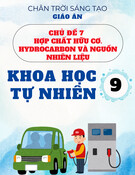
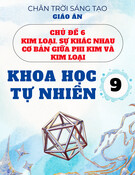
![Giáo án Khoa học tự nhiên 9 Chân Trời Sáng Tạo chủ đề Điện từ: [mô tả/định tính]](https://cdn.tailieu.vn/images/document/thumbnail/2025/20250815/quynhanh02/135x160/560_giao-an-khoa-hoc-tu-nhien-9-chan-troi-sang-tao-chu-de-4-dien-tu.jpg)
